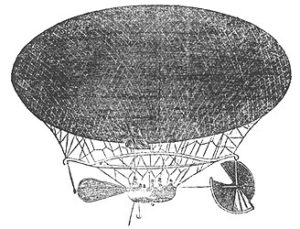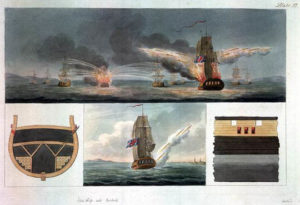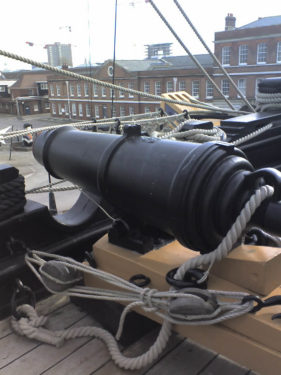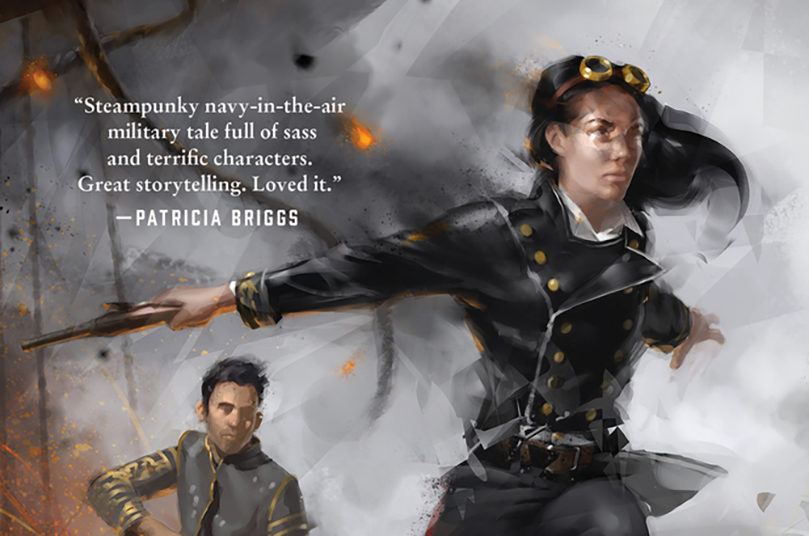 Written by Robyn Bennis
Written by Robyn Bennis
The Guns Above has not always been the book it is now. The title alone has changed several times. Paul Lucas, my agent, sold it under Bring Down the Sky. I worked on it under the title Mistral, which is still the name of the airship at the center of the story. Just before I started writing, however, title and airship were both Zephyr. In the development stage, they were Esper—which I could have sworn was a weather phenomenon, but which turned out to be something I half-remembered from Final Fantasy VI.
Much as the title changed, the technology evolved over the course of development. In the earliest outlines, my protagonist had only recently invented dirigible airships, and the technology was firmly rooted in the story’s original inspiration, Poe’s “Great Balloon Hoax.” In that fabricated newspaper article, Poe describes a propeller-driven airship whose ballast is regulated by a long rope dragged behind.
I soon realized that Poe’s drag rope might also allow an otherwise unpowered airship to sail against the wind. You see, a sailing ship can make headway against the wind because it is rooted in a denser, resisting medium: water. An unpowered airship, with nothing to resist its leeward motion, cannot harness the power of the wind to travel in another direction, but can only drift on it.
However, if a drag rope could generate comparable resistance to a ship in water, a balloon could theoretically propel itself with sails and even tack into the wind. To make this a little more plausible, I made the setting an expansive archipelago, so that the line, and perhaps even a drogue anchor, could be dragged across water rather than land. This was all the better, because now my hero could use her new invention to out-sail the merchant ships that plied those waters, racing ahead of the news of shortages and surpluses, and so finance her inventions with commodities speculation.
Oddly enough, David D. Levine faced a similar problem (in regard to technology, not the commodities market) when designing his interplanetary sailing vessels for Arabella of Mars, and he solved it in much the same way. His ships employ a set of kite-like drag devices which are sent off into adjacent air currents of the interplanetary winds. The idea is quite plausible in that setting, because the difference in wind speed is said to be so great between currents, and the resistance is consequently high.
 My drag rope idea, though similar on the surface, would prove to be anything but plausible. It turned out that a drag rope had already been tried in S. A. Andrée’s Arctic Balloon Expedition of 1897. Far from out-sailing seagoing vessels, Andrée reported that his balloon could only steer ten degrees from the direction of the wind, and modern experts believe that even this meager claim was an absurd exaggeration. Worse, the failure of their sailing scheme was a contributing factor to the deaths of all three expedition members.
My drag rope idea, though similar on the surface, would prove to be anything but plausible. It turned out that a drag rope had already been tried in S. A. Andrée’s Arctic Balloon Expedition of 1897. Far from out-sailing seagoing vessels, Andrée reported that his balloon could only steer ten degrees from the direction of the wind, and modern experts believe that even this meager claim was an absurd exaggeration. Worse, the failure of their sailing scheme was a contributing factor to the deaths of all three expedition members.
My drag rope scheme was a documented failure—the bane of all clever sf/f ideas—so I pushed the technology forward a hundred years or so, past the failures of the poor, doomed protagonist in the early concept. Sails became nacelle-mounted gas turbine engines, crude wicker gondolas became sturdy wooden decks, and—because the first thought of human society whenever presented with new technology is, “that’s great, but how do I kill people with it?”—my age of invention transformed into an age of grinding, brutal warfare.
To match the aesthetic, I imagined the crew of my airship fighting off their enemies with explosive and incendiary rockets. Due to the inaccuracy of such weapons, airships would engage envelope-to-envelope, much like the yardarm-to-yardarm battles of the age of sail. But, as cool as that sounds, it just didn’t play well on the page.  Broadsides of rocketry don’t have the satisfying thunder of cannons, and I could think of no plausible way of following my broadsides with a boarding action—and without a boarding action, a broadside just feels empty, doesn’t it?
Broadsides of rocketry don’t have the satisfying thunder of cannons, and I could think of no plausible way of following my broadsides with a boarding action—and without a boarding action, a broadside just feels empty, doesn’t it?
I therefore retreated a bit, moving the setting from dieselpunk to steampunk, and splitting the difference between my first two concepts. My gas turbines became a crude steam turbine and my decks returned to wicker. My ship became dramatically more fragile for the change, but it also became lighter. What, you think I wasn’t estimating the ship’s weight through all this? Please. My rough calculations indicated that, if my envelope were as large as my dieselpunk concept, but my decks were as light as my sailing concept, I had about a ton and a half of weight to spare.
 And you know what weighs about a ton and a half? Two twelve-pounder carronades, plus ammunition and minimum gun crews. I decided not to waste time or risk disappointment by rechecking my math, but proceeded straight to sketching out the placement and capabilities of what would become Mistral’s light cannons, or “bref guns.” Now, bref guns are still implausible for other reasons—we won’t even contemplate the real-world effect of their recoil on Mistral’s airframe—but let’s be frank here; if you can find the merest excuse to put cannons on your steampunk airship, you put cannons on your steampunk airship, or you’re a damn fool.
And you know what weighs about a ton and a half? Two twelve-pounder carronades, plus ammunition and minimum gun crews. I decided not to waste time or risk disappointment by rechecking my math, but proceeded straight to sketching out the placement and capabilities of what would become Mistral’s light cannons, or “bref guns.” Now, bref guns are still implausible for other reasons—we won’t even contemplate the real-world effect of their recoil on Mistral’s airframe—but let’s be frank here; if you can find the merest excuse to put cannons on your steampunk airship, you put cannons on your steampunk airship, or you’re a damn fool.
Which brings us to His Majesty’s Signal Airship Mistral, as she stands in The Guns Above. Story and technology evolved together over the course of development, laying the groundwork to make the unbelievable into the believable. That, plus the trivial matter of actually writing it, produced a book that ought to satisfy all but the hardest of hard-steampunk aficionados.
Just don’t double-check my math, or we might have to change the title to The Gun Above, and that would just be unfortunate.
Order Your Copy
Find Robyn Bennis online on Twitter (@According2Robyn), Facebook, or visit her website.












